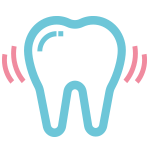
OCLUSIÓN & ATM
Occlusion & TMJ
Occlusion refers to the fit of the teeth, how the upper teeth mesh with the lower ones. When this fit is not perfect, multiple disorders are generated both at the dental level — dental wear, fractures, etc. — and at the tension level — muscle tension, headaches, neck and back pain, ringing in the ears, etc.
What is the TMJ?
The TMJ, or temporomandibular joint, is the connection between the jaw and the head. This joint is very sensitive to poor occlusion, and its misalignment or malfunction can cause bone deformities, wear and/or destruction of the disc, injuries to the ligaments that help maintain the system, etc. If the disorders are not corrected, TMJ degeneration inevitably increases, and over time, arthritis and the well-known craniomandibular dysfunction syndrome (CMD) appear.
What is bruxism??
A bruxist person is someone who clenches their teeth, either in a centric way (statically) or eccentric way (dynamically, or more commonly known as grinding), causing, over time, very pronounced dental wear and TMJ problems.
The main factor in the appearance of bruxism is anxiety, but there is also a clear influence of factors related to occlusion, occlusal disharmony, poor tooth alignment, etc., causing a constant search for the centric or balanced fitting position, which leads to the activation of the facial muscles and the movement of the jaw with its corresponding teeth.
Symptoms
- Headaches, usually on one side of the skull;
- Joint pain (in front of the ear) when pressing;
- Neck pain and stiffness, which can even cause lower back tension;
- Joint noises and clicks that the patient hears as “clicks” when opening/closing, or a gritty sensation throughout the movement;
- Limited maximum opening that makes it impossible to bite apples or large sandwiches;
- Dental wear;
- Tooth sensitivity.
Treatment
The treatment of TMJ or CMD problems is multidisciplinary, as it involves multiple components such as:
- Emotional overloads that need to be treated with relaxation therapies;
- Muscle overloads that need to be treated with osteopaths;
- Dental overload that needs to be treated with a bite splint;
- And when the different occlusal factors causing the poor fit have been identified, correct them through occlusal adjustments, orthodontics, or rehabilitation.
At Clínica Dental Murtra, we will provide you with all the necessary specialists to treat the case in a multidisciplinary manner.
The first phase will consist of making a BITE SPLINT: a removable night device with which we achieve bite balance, relieve muscle tension, progressively eliminate TMJ pain, and prevent the wear of your teeth.
Once the stomatognathic system (teeth, bones, muscles, joint) is under control, it is extremely important to correct the external causes outside the mouth, which is why we work together with an osteopath.
And finally, once we have identified the points that “misalign” the mouth, each case is mounted on a semi-adjustable articulator to perform the occlusion study, where in a very visual way we can show the patient exactly what needs to be corrected:
- In mild cases, eliminate the premature contacts that cause the jaw to deviate;
- In moderate cases, eliminate contacts and restore the vertical dimension lost due to wear;
- In severe cases, move teeth (orthodontics) or rehabilitate the entire mouth so that the teeth fit in that single stable position.
YOUR DOCTOR

Dra. Cristina Murtra
Postgraduate in Aesthetic Dentistry, UB 2016
Doctorate in Health Sciences, UIC 2014
Implant Dentistry Course, Clínica Aparicio & University of Gothenburg 2012
Conservative Dentistry Course, Studio Vanini 2010
Degree in Dentistry, UIC 2008
Medical Director specialized in aesthetics, oral rehabilitation, and occlusion / TMJ.
Being aware that there is nothing better than giving and receiving smiles, I work hard every day gathering and studying proportions, patterns, and measurements in order to restore them when they have been lost.
